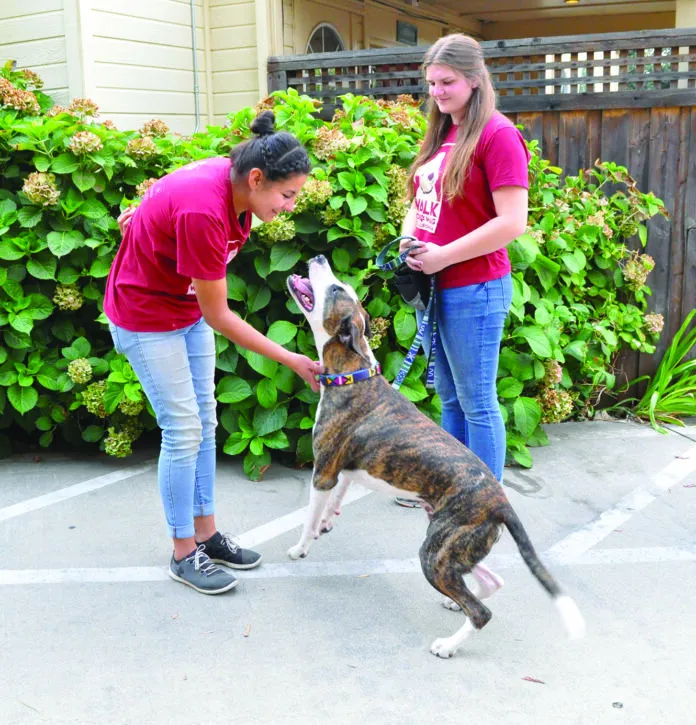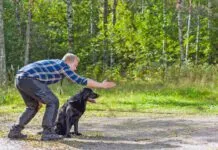Dogs naturally like to jump up. It’s one of the ways they explore the world around them, including the humans they meet.
Unfortunately for our dogs, most people don’t like dogs to jump on them. A rambunctious adolescent Labrador or adult St. Bernard can get in a heap of trouble if they pounce on people, despite their friendly intentions. Even a tiny dog can trip an unstable senior or toddler, or put muddy paw prints on someone’s business suit.
The good news is, we can easily solve this behavioral clash – as long as we first identify the dog’s motivation for jumping up (because the solution will vary depending on the purpose of his paw assault!).
Why Do Dogs Jump?
Greeting and seeking attention from humans are the most common reasons that dogs jump up on us.

Pups learn at an early age that jumping up is the best way to get humans to pay attention to them. After all, they are tiny and way down on the floor, and it’s easy for us to overlook them unless they put their paws on our legs with a “Hi! Hey! I’m down here!” message. Because they’re little and adorable, we bend down and pet them, or at least make eye contact and talk to them. Boom! We just reinforced jumping up.
Because behaviors that are reinforced increase, by the time your jumping pup reaches adolescence, it’s likely that jumping up will have become a well-established behavior.
Dogs also commonly jump up on humans as an information-seeking behavior – frequently in dogs who are not completely comfortable or familiar with humans and who want to find out more about them. “Who are you and what are you going to do to me?”
Often misinterpreted as a warm greeting or attention-seeking, this can get a dog in real trouble when the well-intentioned but misguided human tries to pet the information-seeking dog and elicits a defensive bite instead of happy reciprocal affection.
Finally, a fearful dog may jump on a known and trusted human to seek comfort. In this case, she’s saying, “Help me, I’m scared!” – just as you might seek comfort in the arms of a loved one when you are frightened.
What Not To Do When Your Dog Jumps Up on Someone
It used to be so simple. “Turn your back on the dog and step away” was the standard old-fashioned advice for dealing with a dog who jumps. That’s still a reasonable option for some dogs – with a lot of caveats.
It’s not a good choice for a dog who jumps on you for comfort or information. If a dog jumps up in an effort to gain information about you, you’d be better off standing still; turning away could elicit a bite.
If a dog jumps up in search of comfort, it’s kinder to provide that comfort than to turn away. Meet her needs rather than ignoring her!
If a dog jumps up in an excited, happy greeting or to seek attention, turning your back might work – but she might just keep jumping up on your back, which is still reinforcing because she gets to touch you.
The modern, behavior-science-based approach to jumping up is to figure out how to meet your dog’s needs so she doesn’t have to jump up, and generously reinforce incompatible behaviors as appropriate. Let’s look at how to handle these various jumping up behaviors.
While the following methods work for adult dogs, it’s easier to prevent a behavior from becoming established than it is to modify it after it’s been well-reinforced, so the sooner you start, the better.
What to Do When Your Dog Jumps to Greet
When your new pup comes home, make sure you (and everyone who regularly interacts with her) meet her attention needs so she doesn’t have to jump up to get you to notice her. Pay attention to her by greeting her before she jumps, reinforcing her for four paws on the floor. Teach her that if she sits, people will pay attention to her, and make sure you provide plenty of enrichment opportunities so she isn’t constantly seeking attention for lack of anything better to do.
“Find It” and “Search” are good incompatible behaviors that are easy to teach and simple to use. She can’t do them and jump up at the same time. “Find It” means you’ve dropped treats at your feet. Instead of jumping on you, your dog directs her energy toward the ground, sniffing for treats. For “Search,” toss treats six to eight feet away, again giving your dog something fun to do that’s incompatible with jumping up. You can instruct visitors to do these behaviors as well.
Convince your dog that sitting is a better way to get your attention by providing lots of reinforcement when she sits. You can use a tether to practice; tether her to something solid (such as a sofa leg or piano leg) and approach. If she stays sitting, approach, click and treat (or pet her, or do other reinforcing interactions). If she jumps, step back and wait for her to sit. Then approach.
When you are out and about, restrain her with your leash if someone wants to approach and pet her. Tell them they can pet her if she sits (assuming she enjoys being petted by strangers) and if she jumps up they need to back up. Hold the leash securely so she can’t pull forward and jump on them.
For a fun interactive incompatible behavior, teach your dog that if she sits when visitors come to the door they will throw a toy for her. Then have a basket of toys sitting outside the door with instructions to your visitors to pick up several of them and toss one when your dog sits to greet them. When she comes back and sits, toss the next toy and then the next. You can give your guest a handful of treats while your dog is chasing the toy, and when the toys are all tossed, they can play Find It.
What to Do When Your Dog Jumps for Information
This one’s simpler. If you know your dog is cautious with new people, simply don’t let her approach them (or them approach her), even when they say, “It’s okay, dogs love me!” It’s not okay for your dog, and you must protect her from risky interactions.
A truly dog-knowledgeable person will ignore her if she’s information-seeking and refrain from interacting with her, even if she jumps, until affiliative body language (soft body, soft eyes) conveys that she is relaxed and comfortable with that person. Still, you’re better off preventing interaction in the first place.
What to Do When Your Dog Jumps for Comfort
It’s absolutely fine to comfort your dog when she’s frightened. Don’t worry about “reinforcing” her fear – you cannot reinforce emotion. You can, however, help her survive her fear experience by assuring her that you’ll protect her.
When your dog behaves as if something is scaring her, before she jumps up to seek comfort, do whatever works to comfort her: get down to her level and calmly hold her, reassure her, pet her, move her away from the scary thing, play with her, feed treats, ask for her favorite behaviors, or sit and let her climb in your lap. Depending on how scared she is, she may not be able to take treats, play, or perform behaviors. In that case just hold and comfort her. Be sure you stay calm! Acting worried may stress her more.
Individualize Your Response When Your Dog Jumps
Dog behavior is far more complex than once thought, and modern trainers realize there’s no one-size-fits-all “turn your back” answer for jumping up. It’s more helpful to consider all the parameters – the dog’s motivation for the behavior, what is or is not reinforcing for the individual dog, and how to reinforce incompatible behaviors – and determine how best to work with your own canine companion to teach her how to interact politely with humans.









This is a great article. My 80 pound hound mix tries to jump on family members who visit. In this case, she is definitely trying to greet them. She loves them and gets overexcited. Turning one’s back does not work when she is overexcited. I am going to try some of the ideas in this article. She is a great dog except for this jumping problem.
My labrador is a hyper-greeter and gets over excited. I’ve really worked hard negative behavior but have not had much success.
Good ideas for a jumping dog. However, as a canine behaviorist, barring an aggressive dog, moving back from the jumper, further encourages a reaching out.
The easiest way to discourage a jumping dog is to step forward into their personal space. Watch the body language for any signs of aggression. Keep moving forward and the dog naturally sits or disengages peacefully.
No touching, no eye contact, no need for the handler to choke up on leash.
If you want to practice with a partner, try it.
The person moving into the personal dog space can even use hand signals or verbals to direct the dog to sit, down or stay.
I just did this with my daughter’s 7 month old German shepherd puppy this past weekend while he stayed with us. Worked like a charm; my daughter is continuing to do this at home and he is no longer jumping
I have tried “moving toward” with my flatcoat retriever who was thrilled I wanted to get even closer. We have worked out not jumping on the family, but she still wants to greet people at the park with a sort of side jump, not directly at their face. It doesn’t lend itself easily to training since the issue doesn’t happen with us. She is very friendly and loves new people, but I would really like to change this behaviour without making her apprehensive of new people. Ideas?
What technique did you successfully use to neutralize jumping with family? Then we can adapt a strategy for any strangers.
Pls advise
How did you successfully neutralize jumping with family? Then we can adapt a strategy for any strangers.
Pls advise
I have 2 7 month old pups that get very excited and don’t sit or take treats when they see someone they like. They just keep jumping. Have tried all kinds of these practices and they do not work. I will try moving into their space,
I’ve adopted a 10-12 month old blue heeler. We work daily on basic obedience. I take her out and about for socialization 3-4 times a week. At what point can I expect the breed’s much vaunted Velcro quality to kick in?